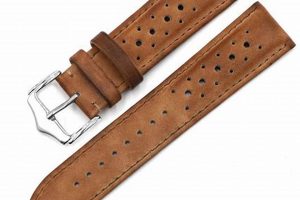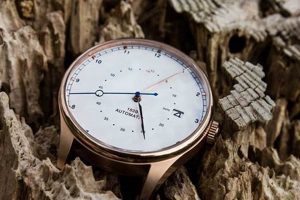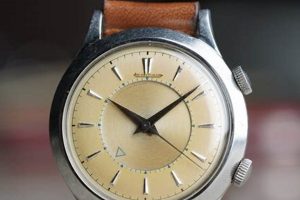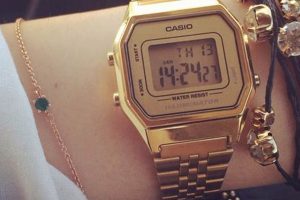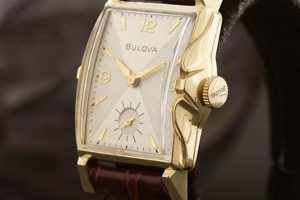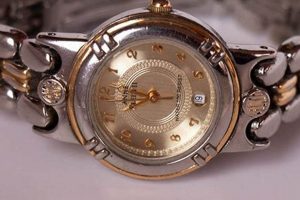Online marketplaces, specifically those specializing in handmade and vintage items, offer a curated selection of timepieces from previous eras. These items, often characterized by unique designs and mechanical movements, provide an alternative to contemporary watch offerings. The availability of these older accessories provides collectors and consumers access to horological history.
Acquiring such items can represent a way to own a piece of the past. They offer benefits such as potential appreciation in value, distinctive aesthetics not found in modern production, and a connection to artisanal craftsmanship. Understanding the historical context and the evolution of watchmaking is beneficial when considering the acquisition of these items, as knowledge of manufacturing techniques and prevalent styles aids in valuation and authentication. The age and origins of these time-tellers represent significant factors for enthusiasts and buyers.
The following sections will delve into considerations for identifying authenticity, evaluating condition, and understanding the nuances of buying and selling collectible wristwatches via online platforms. These factors ensure a satisfactory experience for both buyers and sellers in the pre-owned horology market.
Essential Considerations for Procuring Timepieces from Online Vintage Markets
This section provides advice for navigating the purchase of pre-owned wristwatches via digital platforms. Diligence and informed decision-making are paramount for a successful transaction.
Tip 1: Authenticate the Movement: Thoroughly examine the watch’s movement. Verify the manufacturer markings and caliber number against established resources. Any discrepancies or inconsistencies may indicate a counterfeit or Franken-watch.
Tip 2: Scrutinize the Dial: Analyze the dial for signs of refinishing or damage. Original dials often exhibit a certain patina commensurate with their age. Repainted dials frequently lack the crispness and detail of their authentic counterparts.
Tip 3: Assess the Case Condition: Evaluate the case for over-polishing or excessive wear. Over-polishing can remove sharp lines and soften the overall appearance. Look for consistent wear patterns that align with the watch’s age and use.
Tip 4: Research Seller Reputation: Investigate the sellers feedback and ratings. A history of positive reviews and satisfied customers suggests trustworthiness and reliability. Be wary of sellers with limited or negative feedback.
Tip 5: Request High-Resolution Images: Obtain detailed, high-resolution images of the watch from various angles. This allows for close examination of the dial, case, movement, and any potential flaws or imperfections.
Tip 6: Understand Return Policies: Confirm the seller’s return policy before making a purchase. A reputable seller will typically offer a reasonable return period in case the watch is not as described or has undisclosed issues.
Tip 7: Compare Prices: Conduct thorough price comparisons across different listings and platforms. Significant discrepancies in price may indicate a potential issue or misrepresentation. Factor in condition, rarity, and provenance when evaluating pricing.
These guidelines offer a starting point for the responsible acquisition of vintage wristwatches online. Due diligence and meticulous examination are crucial for minimizing risks and maximizing satisfaction.
The subsequent sections will explore the long-term care and maintenance of vintage timepieces, ensuring their continued operation and preservation.
1. Authenticity Verification
The acquisition of vintage timepieces through online marketplaces necessitates rigorous authentication protocols. Discrepancies between a purported origin and actual construction can result in the purchase of counterfeit or misrepresented items. The prevalence of reproductions in the vintage watch market underscores the importance of confirming the legitimacy of offered timepieces. For example, a watch advertised as a specific model from a particular year must be verified against the manufacturer’s historical records and design specifications. Without such validation, consumers face the financial risk of investing in inauthentic goods.
Authentication processes involve a multi-faceted approach, encompassing examination of the movement, dial, case, and associated paperwork. Serial numbers, hallmarkings, and component consistency with known manufacturing practices are critical indicators. Furthermore, expert appraisal by horologists or watch specialists provides an objective assessment of originality. These measures enable buyers to minimize the risks associated with misleading product listings and ensure the integrity of their investment. Consider a situation where a seller has a generic photo, but has a high price point, this is an indication that buyers can consider.
In summary, stringent authentication represents a cornerstone of responsible engagement in the vintage timepiece market. A cautious approach, combining meticulous inspection and expert consultation, mitigates the risk of acquiring spurious items. Protecting consumers from deceitful practices contributes to market stability and preserves the historical value of genuine vintage watches, while supporting the marketplace viability of platforms like Etsy.
2. Condition Assessment
The evaluation of condition constitutes a pivotal aspect of acquiring vintage timepieces through online marketplaces. The age and previous use of such items necessitate a thorough examination to determine functionality, originality, and potential restoration needs. A watch advertised on an online platform might appear aesthetically pleasing in initial photographs, but a more detailed condition assessment may reveal underlying mechanical issues or structural damage. The correlation between condition and value is direct; a well-preserved, fully functional timepiece will command a higher price than a similar model exhibiting significant wear or requiring extensive repairs.
Practical assessment involves scrutinizing the dial for blemishes, the case for scratches or corrosion, and the movement for operational integrity. The presence of original components, such as hands, crowns, and crystals, contributes to the watch’s overall value and collectibility. Furthermore, the accuracy of timekeeping and the duration of power reserve provide insights into the movement’s health. Online platforms often provide tools for communicating with sellers, enabling potential buyers to request additional photographs or information to aid in their condition assessment. Failure to conduct a comprehensive evaluation exposes the buyer to the risk of purchasing a watch that requires costly repairs or does not align with their expectations.
In conclusion, condition assessment represents a critical step in the acquisition of vintage timepieces. Thorough evaluation of aesthetic and functional aspects minimizes the potential for unexpected expenses or disappointment. A detailed understanding of condition assessment principles enhances the buyer’s ability to make informed decisions and secure a valuable and satisfying addition to their collection. While challenges exist in accurately assessing condition remotely, employing meticulous scrutiny and utilizing communication tools can mitigate risks and ensure a more favorable outcome.
3. Seller Reputation
The purchase of vintage timepieces on platforms like Etsy inherently involves a level of risk, primarily due to the pre-owned nature of the goods and the potential for misrepresentation. Seller reputation, therefore, serves as a critical mitigating factor in these transactions. A seller’s history of positive feedback, transparent communication, and accurate product descriptions directly influences buyer confidence. For example, a seller with numerous positive reviews detailing the accurate representation of watch condition and prompt resolution of issues establishes credibility. Conversely, a seller with a pattern of negative feedback or unresolved disputes raises significant concerns regarding the reliability of their offerings. The cause-and-effect relationship is clear: a strong seller reputation leads to increased buyer trust and, ultimately, more successful transactions within the vintage timepiece market.
The absence of verifiable seller reputation necessitates a heightened level of scrutiny on the part of the buyer. Without a proven track record, the buyer must rely solely on product descriptions and photographs, increasing the risk of encountering misrepresented or non-functional items. In such instances, third-party authentication services and escrow arrangements may be considered to safeguard the buyer’s interests. Consider the hypothetical scenario of two listings for the same model of vintage watch. One listing is from a seller with hundreds of positive reviews and detailed condition reports. The other is from a seller with no reviews and vague descriptions. The increased risk associated with the latter listing should be reflected in a lower price point, or, more prudently, avoided altogether.
In summary, seller reputation functions as a fundamental component of trust and security within the “etsy vintage watches” ecosystem. A demonstrable history of ethical and reliable business practices significantly reduces the risks associated with acquiring pre-owned timepieces online. While challenges remain in objectively quantifying and verifying seller reputation, the principles of due diligence and cautious assessment remain paramount. Prioritizing established sellers with positive feedback loops reinforces the integrity of the vintage watch market and promotes a more secure and satisfying experience for buyers. The understanding of this dynamic is of great practical significance.
4. Pricing Discrepancies
Pricing discrepancies in the “etsy vintage watches” market represent a significant factor impacting buyer decision-making. The variations observed often stem from a complex interplay of factors, including condition, rarity, provenance, and seller expertise. Understanding these nuances is essential for informed acquisitions.
- Condition Variance
The state of preservation directly influences valuation. A watch in pristine, original condition typically commands a premium compared to a similar model exhibiting wear, damage, or non-original components. Minor cosmetic flaws can lead to noticeable price reductions. This pricing variance impacts the perceived value and attractiveness of specific listings within the online marketplace.
- Rarity and Production Numbers
Limited production runs or unique variations contribute to increased scarcity and, consequently, higher prices. Timepieces with documented historical significance or those produced in limited quantities often exhibit substantial price premiums. This rarity-driven inflation is a key driver of pricing discrepancies across different “etsy vintage watches” listings.
- Provenance and Historical Association
If a watch can be verifiably linked to a notable individual or event, its value often increases significantly. Documented ownership or historical relevance acts as a premium driver, distinguishing the item from comparable models lacking such documentation. The proven existence of previous ownership affects valuation which explains the reason of pricing discrepancies across different “etsy vintage watches” listings.
- Seller Expertise and Markup
The knowledge and reputation of the seller influence pricing strategies. Established dealers with extensive experience may command higher prices due to their expertise in authentication and restoration. Conversely, less experienced sellers might offer lower prices to attract buyers. Different markups or seller-specific commissions affect valuation which creates pricing discrepancies across different “etsy vintage watches” listings.
These facets collectively contribute to the diverse pricing landscape observed within the “etsy vintage watches” market. Recognizing these factors enables buyers to assess the value proposition of individual listings and make informed purchasing decisions, mitigating the risks associated with overpayment or misrepresented items.
5. Movement Functionality
The operational integrity of a vintage watch movement represents a core determinant of value and desirability within the online marketplace. Mechanical timepieces, particularly those offered through platforms specializing in pre-owned goods, require careful assessment to ensure accurate timekeeping and long-term reliability. The functional status dictates utility and worth.
- Timekeeping Accuracy
A fundamental attribute of any watch movement is its ability to maintain accurate time. Deviations beyond acceptable tolerances, often measured in seconds per day, can indicate underlying mechanical issues. For “etsy vintage watches,” timekeeping accuracy directly impacts user satisfaction and perceived value. A vintage watch that fails to keep reasonably accurate time diminishes its practicality and collectability.
- Power Reserve
The power reserve denotes the duration a mechanical watch will operate after being fully wound. A diminished power reserve may signal wear or damage to the mainspring or other movement components. In the context of “etsy vintage watches,” a compromised power reserve represents a functional defect that reduces the watch’s usability and potentially increases the need for costly repairs.
- Winding Mechanism
The smooth and efficient operation of the winding mechanism is critical for manual and automatic watches. Resistance, grinding, or slippage during winding can indicate internal problems. For buyers of “etsy vintage watches,” a faulty winding mechanism raises concerns about the overall condition of the movement and its potential for requiring immediate service.
- Overall Mechanical Condition
Beyond individual components, the overall mechanical condition of the movement is paramount. This encompasses the presence of corrosion, wear, or damage to gears, pinions, and other critical parts. When assessing “etsy vintage watches,” a mechanically sound movement suggests a history of proper care and maintenance, increasing its desirability and potential for continued reliable operation.
The interplay of timekeeping accuracy, power reserve, winding mechanism functionality, and overall mechanical integrity dictates the value of “etsy vintage watches”. Understanding these functional facets empowers buyers to make informed decisions, mitigating the risks associated with acquiring timepieces requiring extensive repairs or possessing limited operational lifespan. Assessing movement functionality is therefore crucial for satisfaction.
6. Return Policies
The establishment and enforcement of return policies are intrinsic to consumer confidence within online marketplaces, particularly for items such as “etsy vintage watches,” where subjective assessments of condition and authenticity prevail. The presence of clearly defined return parameters mitigates risks associated with remote transactions.
- Mitigation of Misrepresentation Risks
A transparent return policy provides a mechanism for buyers to address discrepancies between the item’s description and its actual condition. This is crucial in the “etsy vintage watches” market, where nuances such as dial patina, movement originality, and case polishing can be subjective. A return policy allows buyers to rectify purchases if the timepiece deviates from the seller’s representation. The policies of various marketplaces impact the final transaction.
- Protection Against Undisclosed Defects
Return policies offer recourse against latent defects not readily apparent at the time of purchase. For “etsy vintage watches,” this might encompass mechanical issues such as inaccurate timekeeping or reduced power reserve, which may only become evident after a period of use. The ability to return an item with undisclosed defects shields buyers from unforeseen repair costs. The protection of purchases is an impact of return policies.
- Facilitation of Authentication Verification
A clearly defined return window allows buyers to seek independent authentication of the timepiece. This is vital in mitigating the risk of purchasing counterfeit or heavily modified “etsy vintage watches.” The ability to return the item pending professional assessment incentivizes sellers to provide accurate descriptions and facilitates due diligence by the buyer. Third party opinions are protected by return policies.
- Enhancement of Market Trust and Seller Accountability
The presence of a robust return policy fosters trust within the “etsy vintage watches” market. It signals seller accountability and a willingness to stand behind their offerings. This, in turn, encourages responsible listing practices and accurate representations of item condition. The buyer benefits from a return policy and that is a factor to consider.
The presence and enforcement of equitable return policies directly influence the viability and integrity of the “etsy vintage watches” market. They provide a crucial safeguard for buyers, promote ethical selling practices, and contribute to a more transparent and trustworthy online environment for trading vintage horological items.
Frequently Asked Questions Regarding “etsy vintage watches”
This section addresses common inquiries and misconceptions concerning the acquisition of vintage timepieces via the Etsy platform. The information provided aims to equip prospective buyers with essential knowledge for making informed decisions.
Question 1: What constitutes a “vintage” watch in the context of Etsy listings?
The term “vintage,” as generally applied to timepieces, refers to watches manufactured prior to approximately the 1990s. However, individual sellers on Etsy may employ differing criteria. Prospective buyers should carefully review listing descriptions to ascertain the specific age or characteristics that qualify a watch as “vintage” according to the seller.
Question 2: How can authenticity be verified when purchasing “etsy vintage watches”?
Authenticity verification requires meticulous examination of the watch’s components, including the movement, dial, case, and markings. Buyers should request high-resolution photographs and seek clarification from the seller regarding provenance and service history. Consulting with a qualified horologist for professional appraisal is advisable for high-value acquisitions.
Question 3: What factors influence the pricing of “etsy vintage watches”?
Pricing is determined by a confluence of variables, encompassing condition, rarity, brand reputation, historical significance, and seller expertise. Timepieces in exceptional condition, those produced in limited quantities, and those associated with notable historical events typically command premium prices.
Question 4: What recourse is available if a purchased “etsy vintage watch” is not as described?
Buyers should familiarize themselves with Etsy’s buyer protection policies and the specific return policies offered by the seller. In cases of misrepresentation or undisclosed defects, buyers may be eligible for a refund or exchange, provided they adhere to the stipulated procedures and timelines.
Question 5: How can the risk of purchasing a non-functional “etsy vintage watch” be minimized?
Mitigating this risk requires diligent inquiry into the watch’s service history and functional status. Buyers should request detailed information regarding timekeeping accuracy, power reserve, and recent servicing. Independent verification of functionality by a qualified watchmaker is recommended post-purchase.
Question 6: What are the implications of purchasing a “etsy vintage watch” with non-original components?
The presence of non-original components, such as dials, hands, or straps, can significantly impact the collectability and value of a vintage timepiece. Buyers should inquire specifically about the originality of all components and assess the impact on their intended use and investment objectives.
In summary, acquiring “etsy vintage watches” necessitates a cautious and informed approach. Thorough due diligence, encompassing authenticity verification, condition assessment, and adherence to established return policies, is paramount for minimizing risks and maximizing satisfaction.
The following section provides guidance on the ongoing maintenance and care of vintage timepieces, ensuring their continued operation and preservation.
Considerations Regarding “etsy vintage watches”
The preceding discourse has outlined vital elements pertaining to the “etsy vintage watches” market. From authentication protocols and condition assessments to the crucial role of seller reputation and the complexities of pricing discrepancies, it becomes evident that acquiring vintage timepieces through online platforms demands a discerning approach. Functional integrity, encompassing timekeeping accuracy and power reserve, remains paramount. Equitable return policies serve as a cornerstone for buyer confidence and market stability.
The marketplace for “etsy vintage watches” presents both opportunities and challenges. Prospective buyers must approach potential acquisitions with diligence and informed decision-making, prioritizing verifiable information and exercising caution in the face of uncertainty. Prudent evaluation and a thorough understanding of the market dynamics are essential for navigating the inherent complexities and securing a worthwhile investment in horological history. The longevity of these items relies on proper care and thoughtful curation within responsible ownership.


